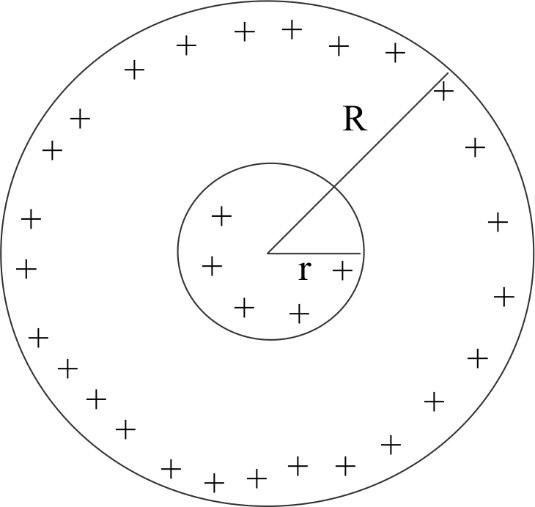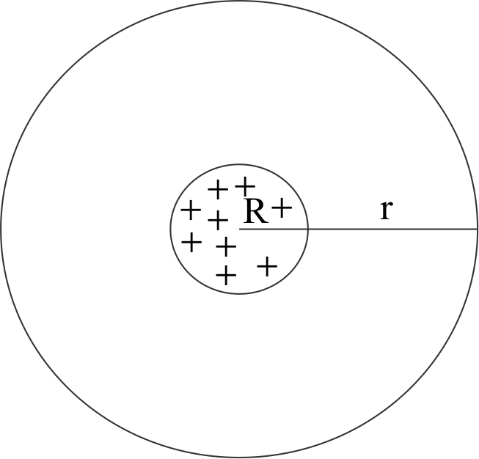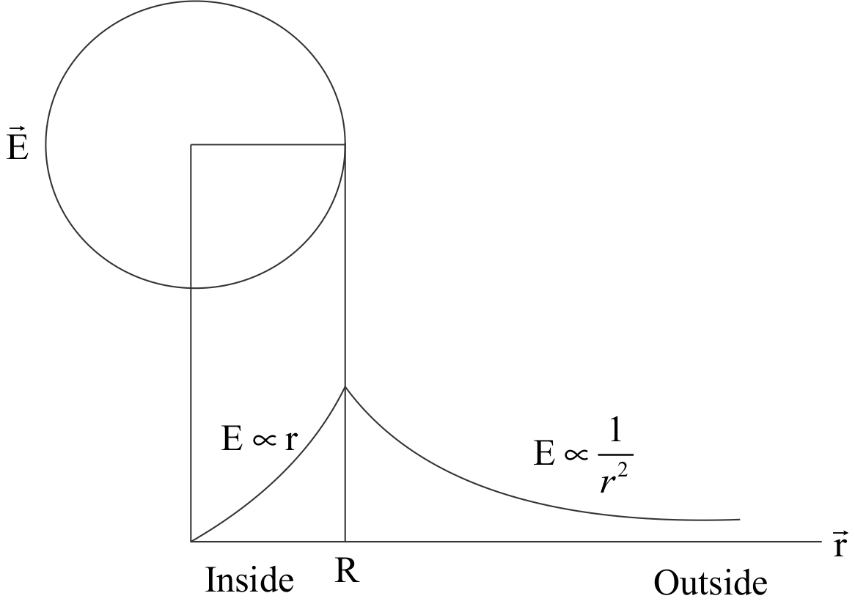
Electric field due to uniformly charged sphere.
Answer
173.4k+ views
Hint: This is the case of solid non-conducting spheres. We will have three cases associated with it . They are : electric fields inside the sphere, on the surface, outside the sphere .
Apply the gauss theorem to find the electric field at the three different places.
Complete step by step solution:
Consider a charged solid sphere of radius $R$ and charge $q$ which is uniformly distributed over the sphere. We will use Gauss Theorem to calculate electric fields. If $\phi $ be the electric flux and $Q$ be the charge then :
${\varepsilon _0}\phi = {Q_{enclosed}}$
Also , electric flux=electric field X area of the enclosed surface : $\phi = EA$
Case I- Inside the sphere $(r < R)$

The charge distribution is uniform . Volume density will be the same. Let the charge enclosed by a circle of radius $r$ be $q'$ . Since volume density is same then-
$
\dfrac{{q'}}{{\dfrac{4}{3}\pi {r^3}}} = \dfrac{q}{{\dfrac{4}{3}\pi {R^3}}} \\
q' = q\dfrac{{{r^3}}}{{{R^3}}} \\
$
Applying Gauss Theorem here-
$
\phi = E4\pi {r^2} \\
\dfrac{{{Q_{enclosed}}}}{{{\varepsilon _0}}} = E4\pi {r^2} \\
\dfrac{{q'}}{{{\varepsilon _0}}} = E4\pi {r^2} \\
\dfrac{q}{{{\varepsilon _0}}} \times \dfrac{{{r^3}}}{{{R^3}}} = E4\pi {r^2} \\
E = \dfrac{1}{{4\pi {\varepsilon _0}}} \times \dfrac{{qr}}{{{R^3}}} \\
$
This is the electric field inside the charged sphere .
Case II: On the surface $(r = R)$
In the above case we have calculated the electric field inside the sphere. In that formula we will put $(r = R)$ , so evaluate the electric field on the surface of the sphere .
$
E = \dfrac{1}{{4\pi {\varepsilon _0}}} \times \dfrac{{qr}}{{{R^3}}} \\
E = \dfrac{1}{{4\pi {\varepsilon _0}}} \times \dfrac{{qR}}{{{R^3}}} \\
E = \dfrac{1}{{4\pi {\varepsilon _0}}} \times \dfrac{q}{{{R^2}}} \\
$
This is the electric field on the surface.
Case III: Outside the sphere $(r > R)$

We will apply Gauss theorem in this too.
$
\phi = EA \\
\dfrac{q}{{{\varepsilon _0}}} = E4\pi {r^2} \\
E = \dfrac{1}{{4\pi {\varepsilon _0}}} \times \dfrac{q}{{{r^2}}} \\
$
This is the electric field outside the sphere.
If we plot these variations on a graph we will get the following graph:

Note: Since this is a solid sphere , it has charge inside it as well and that is why the electric field is non zero. In case of a hollow spherical shell, the electric field inside the shell is zero .
Apply the gauss theorem to find the electric field at the three different places.
Complete step by step solution:
Consider a charged solid sphere of radius $R$ and charge $q$ which is uniformly distributed over the sphere. We will use Gauss Theorem to calculate electric fields. If $\phi $ be the electric flux and $Q$ be the charge then :
${\varepsilon _0}\phi = {Q_{enclosed}}$
Also , electric flux=electric field X area of the enclosed surface : $\phi = EA$
Case I- Inside the sphere $(r < R)$

The charge distribution is uniform . Volume density will be the same. Let the charge enclosed by a circle of radius $r$ be $q'$ . Since volume density is same then-
$
\dfrac{{q'}}{{\dfrac{4}{3}\pi {r^3}}} = \dfrac{q}{{\dfrac{4}{3}\pi {R^3}}} \\
q' = q\dfrac{{{r^3}}}{{{R^3}}} \\
$
Applying Gauss Theorem here-
$
\phi = E4\pi {r^2} \\
\dfrac{{{Q_{enclosed}}}}{{{\varepsilon _0}}} = E4\pi {r^2} \\
\dfrac{{q'}}{{{\varepsilon _0}}} = E4\pi {r^2} \\
\dfrac{q}{{{\varepsilon _0}}} \times \dfrac{{{r^3}}}{{{R^3}}} = E4\pi {r^2} \\
E = \dfrac{1}{{4\pi {\varepsilon _0}}} \times \dfrac{{qr}}{{{R^3}}} \\
$
This is the electric field inside the charged sphere .
Case II: On the surface $(r = R)$
In the above case we have calculated the electric field inside the sphere. In that formula we will put $(r = R)$ , so evaluate the electric field on the surface of the sphere .
$
E = \dfrac{1}{{4\pi {\varepsilon _0}}} \times \dfrac{{qr}}{{{R^3}}} \\
E = \dfrac{1}{{4\pi {\varepsilon _0}}} \times \dfrac{{qR}}{{{R^3}}} \\
E = \dfrac{1}{{4\pi {\varepsilon _0}}} \times \dfrac{q}{{{R^2}}} \\
$
This is the electric field on the surface.
Case III: Outside the sphere $(r > R)$

We will apply Gauss theorem in this too.
$
\phi = EA \\
\dfrac{q}{{{\varepsilon _0}}} = E4\pi {r^2} \\
E = \dfrac{1}{{4\pi {\varepsilon _0}}} \times \dfrac{q}{{{r^2}}} \\
$
This is the electric field outside the sphere.
If we plot these variations on a graph we will get the following graph:

Note: Since this is a solid sphere , it has charge inside it as well and that is why the electric field is non zero. In case of a hollow spherical shell, the electric field inside the shell is zero .
Recently Updated Pages
JEE Main Mock Test 2025-26: Chapter-Wise Practice Papers

JEE Main Electromagnetic Waves Mock Test 2025-26 | Free Practice Online

JEE Main 2025-26 Electronic Devices Mock Test: Free Practice Online

JEE Main Mock Test 2025-26: Current Electricity Practice Online

JEE Main 2025-26 Electrostatics Mock Test – Free Practice Online

JEE Main 2025-26 Units and Measurements Mock Test Online

Trending doubts
Uniform Acceleration

Atomic Structure - Electrons, Protons, Neutrons and Atomic Models

Learn About Angle Of Deviation In Prism: JEE Main Physics 2025

Enthalpy of Combustion with Examples for JEE

Instantaneous Velocity - Formula based Examples for JEE

Electron Gain Enthalpy and Electron Affinity for JEE

Other Pages
JEE Main 2025: Conversion of Galvanometer Into Ammeter And Voltmeter in Physics

Degree of Dissociation and Its Formula With Solved Example for JEE

What is Hybridisation in Chemistry?

Current Loop as Magnetic Dipole and Its Derivation for JEE

The ratio of the lengths densities masses and resistivities class 12 physics JEE_Main

The potential of A is 10V then the potential of B is class 12 physics JEE_Main




